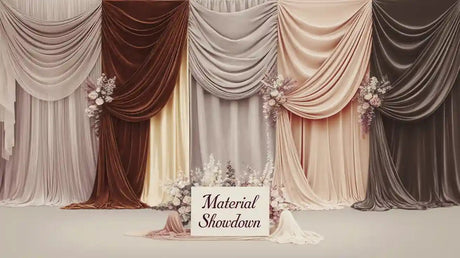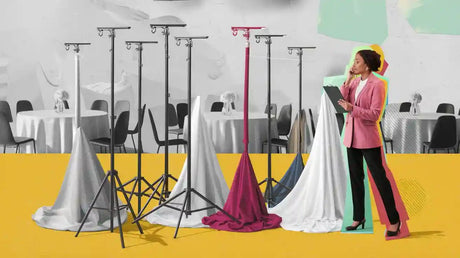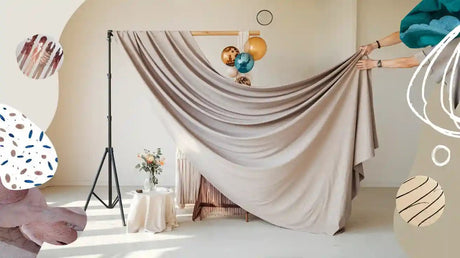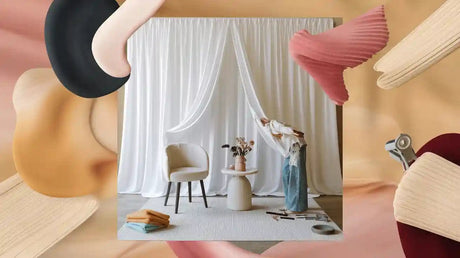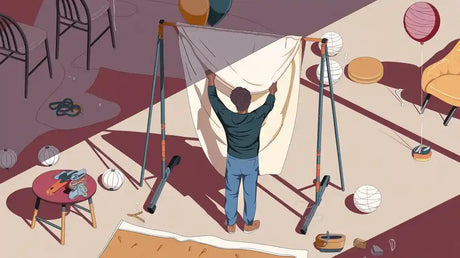
Keeping your patio furniture safe begins with a strong cover. A tough outdoor chair cover protects chairs from rain, sun, and dust. It also saves you money by making your furniture last longer. When picking covers, choose good quality to handle bad weather.
Key Takeaways
Pick tough materials like polyester or coated canvas for covers. These materials block water, sunlight, and damage, keeping chairs safe.
Measure your chairs carefully before getting covers. A tight fit blocks wind and rain, protecting your patio furniture better.
Find covers with adjustable parts like stretchy hems or strings. These keep covers in place and stop them from flying off in storms.
Choose Durable Materials for Outdoor Chair Covers
Pick strong fabrics like polyester or canvas
To protect your patio furniture, the fabric matters a lot. Strong materials like polyester and canvas work well for outdoor chair covers. Polyester is great because it resists water and stays tough. It can handle rain, snow, and strong winds without wearing out. For extra strength, 600D polyester canvas is a top choice. It’s weatherproof and protects against sun, wind, and rain, helping your furniture last longer.
Canvas is also very sturdy and can handle rough use. Over time, it softens, making it easier to use. But untreated canvas can soak up water, so treated versions are better for rainy places. Both fabrics allow air to flow, which stops mold and mildew from growing on your furniture.
Tip: Always pick strong materials that can handle your area’s weather to make your covers last longer.
Choose UV-resistant coatings to stop sun damage
The sun can harm outdoor furniture by fading and weakening it. That’s why UV-resistant coatings are important for outdoor chair covers. These coatings block harmful UV rays, keeping your furniture safe from damage. They also keep the colors of your covers bright and fresh for a long time.
UV-resistant coatings are especially useful if your patio gets lots of sunlight. They help your covers survive many hot summers without losing their strength. By picking UV-proof materials, you protect your furniture and make your covers last longer.
Note: UV-resistant coatings help keep your patio furniture looking new and in good shape.
Ensure Proper Sizing for Your Patio Furniture Covers
Measure your chairs carefully for a good fit
To get the right size covers, measure your chairs well. A good fit keeps your furniture safe from weather and dirt. Follow these steps to measure your chairs:
Measure when the chair is fully set up for accuracy.
Clear the area around the chair to avoid any blocks.
Write down the numbers right away so you don’t forget.
Check your measurements twice to avoid mistakes or shrinkage.
Start by measuring the height from the ground to the top of the backrest. Next, measure the width across the widest part, usually the arms. Lastly, measure the depth from the front of the seat to the backrest. These steps help your covers fit well and protect your furniture better.
Tip: Always double-check your numbers. A snug cover looks nice and keeps out wind and rain.
Choose covers with elastic hems or drawstrings
Even with good measurements, adjustable features help covers fit better. Elastic hems and drawstrings keep covers tight and stop them from slipping off. They also adjust to fit slightly odd shapes or sizes.
Drawstrings are great for holding covers firmly in place. They wrap tightly around furniture, even during strong winds. Elastic tie-downs stretch to fit unique shapes but stay strong. Both options make covers more protective and easier to use.
Note: Adjustable features help covers stay in place and last longer, even in bad weather.
Focus on Weather Protection to Handle Outdoor Conditions
Pick waterproof or water-resistant fabrics
For outdoor furniture, the right material is very important. Waterproof covers are the best for keeping rain and snow away. They block water completely, keeping furniture dry during heavy rain. If your area doesn’t get much rain, water-resistant covers can work too. These covers repel light rain or dew but aren’t fully waterproof.
Here’s a simple comparison of materials:
Material Type |
Water Resistance |
UV Resistance |
Durability |
|---|---|---|---|
Polyester |
Yes |
Yes |
High |
Other Options |
Varies |
Varies |
Varies |
Polyester is a strong choice for waterproof and UV-resistant covers. It lasts long, resists fading, and doesn’t tear easily. Using waterproof covers helps your furniture last longer and look good all year.
Tip: Check the label to see if the material is waterproof or just water-resistant.
Look for windproof designs for stormy weather
Strong winds can blow covers off your furniture. To stop this, choose covers with windproof features like clips or clamps. Clips fit tightly around furniture and stay secure during storms. They are easy to use and keep covers in place. Clamps are stronger and use elastic parts to hold covers firmly, even in strong winds.
Why windproof features are helpful:
Clips are easy to attach and remove.
Both save time and protect furniture well.
Windproof covers give peace of mind during storms. They keep your furniture safe, even in bad weather.
Note: Windproof covers are great for areas with lots of storms or strong winds.
Patio Furniture Covers Need Strong Fasteners
Pick covers with straps, buckles, or Velcro for security
Fasteners are important to keep your patio furniture covers in place. Options like straps, buckles, and Velcro work well for this. These fasteners hold covers tightly, even on windy days. Straps wrap around furniture for a snug fit that stays put. Buckles are adjustable and fit different furniture sizes easily. Velcro is simple to use and makes putting on or taking off covers quick.
Here’s a simple comparison of fasteners:
Fastener Type |
Benefits |
Weather Resistance |
|---|---|---|
Straps |
Tight fit, great for strong winds. |
High |
Buckles |
Adjustable, fits many furniture types. |
High |
Velcro (Hook & Loop) |
Easy to use, stays secure in bad weather. |
High |
Drawstrings |
Quick fit, strong coverage during windy conditions. |
High |
Using these fasteners helps protect your furniture from moving or getting uncovered.
Tip: Choose covers with more than one fastener type for better security.
Make sure fasteners can handle strong winds
Fasteners should be strong enough to stay secure in storms. Grommets and cords are good for tying covers tightly to furniture. Adjustable ties and buckle straps add extra security against wind and rain. Elastic hems are also helpful because they fit snugly without needing extra tools.
Why strong fasteners are useful:
Grommets and cords fit tightly on different furniture shapes.
Tie-downs and straps keep covers steady in bad weather.
Elastic hems hold covers firmly, even in strong winds.
Covers with tough fasteners protect your furniture and last longer.
Note: Secure covers properly to keep furniture safe from sudden weather changes.
Protect Furniture with Inner Lining Features
Choose soft inner linings to stop scratches
When picking outdoor furniture covers, check for soft inner linings. These linings act like cushions, stopping scratches on delicate surfaces. Windy days can make covers move and rub against furniture. This rubbing can cause ugly marks over time. A soft lining helps prevent this, keeping your furniture safe and looking new.
Soft linings are great for furniture that gets moved often. Whether you’re rearranging or storing chairs, the lining protects them. It also helps stop mold and mildew by keeping moisture away.
Tip: Look inside the cover for smooth, soft material. This small feature can protect your furniture a lot.
Stay away from rough or sticky materials
Not all covers are good for your furniture. Some rough or sticky materials can harm surfaces over time. Sticky ones might stick to paint in hot weather, peeling it off. Rough ones can scratch or damage furniture, which defeats the purpose of a cover.
To avoid this, pick covers with smooth, soft inner layers. This is very important for furniture with shiny or painted finishes. A good cover with a soft lining stops scratches and removes easily without sticking.
Note: Spending on quality covers with soft linings saves money on repairs later.
Check Stitching Quality for Long-Lasting Durability
Look for double-stitched seams for added strength
Good stitching is key for strong outdoor furniture covers. Double-stitched seams are very important. They make covers tougher and able to handle daily use and bad weather. These seams act like extra protection for your furniture. A loveseat cover review showed that double-stitched seams make covers last longer. They resist damage from wind and rain, keeping your furniture safe.
Double stitching also helps covers keep their shape and fit well. It stops seams from coming apart, which can let in water or dirt. If you want covers that last a long time, choose ones with double-stitched seams.
Tip: Check the product details or look closely at the seams before buying. Double stitching makes a big difference in durability.
Avoid covers with loose or uneven stitching
Loose or messy stitching is a bad sign for covers. It makes them weaker and easier to tear. During heavy rain, poor stitching can let water leak through and ruin your furniture. Waterproof stitching is needed to stop leaks and keep moisture out.
Here’s why good stitching matters:
Aspect |
Importance |
|---|---|
Makes covers durable and fit properly. |
|
Waterproof stitching sealing |
Stops water from leaking in and protects furniture. |
Look closely at the stitching. Uneven threads or gaps can make covers fail. Well-stitched covers not only work better but also last longer.
Note: Spending on good stitching means fewer replacements and a nicer patio.
Compare Fabric Types for Patio Furniture Covers
Learn about vinyl, polyester, and canvas materials
Picking the right fabric for patio covers is important. Vinyl, polyester, and canvas are common choices. Each has good and bad points.
Vinyl: Vinyl is fully waterproof, great for rainy or snowy places. Cleaning it is simple—just wipe with a wet cloth. But it doesn’t let air through, which can trap moisture and cause mold.
Polyester: Polyester is light, strong, and resists water and sun damage. It works well in sunny or rainy weather and doesn’t crack like vinyl. However, it’s not as tough as canvas in harsh conditions.
Canvas: Canvas is very strong and handles wear well. It lets air flow, stopping mold, and softens over time for easier use. But untreated canvas isn’t waterproof, so treated versions are better for wet areas.
Tip: Think about your weather and how often you’ll use the covers before choosing a fabric.
Pick a fabric that fits your weather and care needs
Your weather affects which fabric is best for you. For example:
In sunny places, choose UV-protected fabrics like polyester or Sunbrella®. These keep colors bright and resist fading.
For rainy or snowy areas, waterproof vinyl or treated canvas keeps furniture dry.
If your weather changes a lot, durable fabrics like polyester or recycled plastic are a good choice.
Also, think about how much care the fabric needs. Vinyl is easy to clean but can crack if not handled carefully. Polyester and canvas are easier to maintain and can often be washed in a machine. Choosing the right fabric for your weather and care routine helps your covers last longer.
Note: Spending on the right fabric now saves money on replacements later.
Review Maintenance and Cleaning Ease
Choose covers that are simple to clean
Think about cleaning when picking outdoor furniture covers. Machine-washable covers are very convenient. Just put them in the washer, and they’ll be clean and ready. This is useful if your patio gets dusty or has bird droppings.
If machine-washable covers aren’t available, pick wipe-clean materials. Fabrics like polyester or vinyl are easy to clean with a damp cloth. This makes cleaning quick and simple.
Tip: Always read the care instructions. Easy-to-clean covers save time and effort.
Stay away from covers needing too much care
Some covers take too much work to maintain. For example, untreated canvas needs waterproof sprays often. Covers with tricky cleaning steps can also be frustrating. You don’t want to spend hours cleaning or worrying about damage.
Choose low-maintenance covers that match your lifestyle. Strong fabrics like polyester or treated canvas are good options. They resist stains and need little care. By avoiding high-maintenance covers, you’ll have more time to relax on your patio.
Note: Easy-care covers save time and keep your furniture looking great.
Picking the right outdoor chair cover helps protect your patio furniture. Follow these 8 tips to find covers that fit well and last long. Good-quality covers save money by reducing replacements and keeping furniture safe.
Here’s why strong covers are important:
Tough fabrics block sun, wind, and rain.
Tear-proof materials survive bad weather.
Waterproof covers stop water damage.
UV coatings prevent fading and wear.
Durable covers, like polyester ones, resist water and fading. They are lightweight and simple to use. They’re a great choice for long-lasting protection. Start looking now and keep your patio furniture in top shape!
FAQ
What is the best material for outdoor chair covers?
Polyester is a great choice. It’s durable, water-resistant, and lightweight. Treated canvas works well too, especially in windy areas. Choose based on your local weather conditions.
How do I clean my outdoor chair covers?
Most covers are easy to clean. Machine-washable ones are convenient. For others, wipe them with a damp cloth. Always check the care label for specific instructions.
Can I use one-size-fits-all covers for my chairs?
It’s better to avoid them. Custom-fit covers protect your furniture better. Measure your chairs and choose covers with adjustable features like elastic hems or drawstrings for a snug fit.
Tip: Properly fitted covers last longer and provide better protection.



